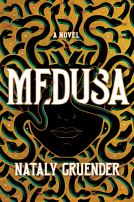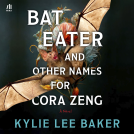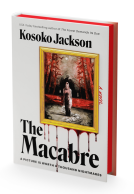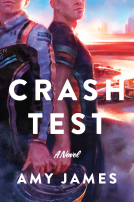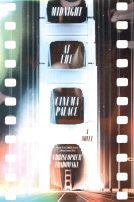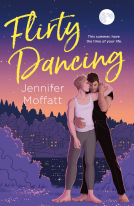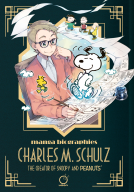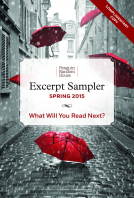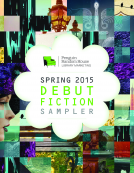
Nightmare Fuel
The Science of Horror Films
by Nina Nesseth
This title was previously available on NetGalley and is now archived.
Send NetGalley books directly to your Kindle or Kindle app
1
To read on a Kindle or Kindle app, please add kindle@netgalley.com as an approved email address to receive files in your Amazon account. Click here for step-by-step instructions.
2
Also find your Kindle email address within your Amazon account, and enter it here.
Pub Date Jul 26 2022 | Archive Date Nov 15 2022
Macmillan-Tom Doherty Associates | Tor Nightfire
Talking about this book? Use #NightmareFuel #NetGalley. More hashtag tips!
Description
Nightmare Fuel by Nina Nesseth is a pop-science look at fear, how and why horror films get under our skin, and why we keep coming back for more.
Do you like scary movies?
Have you ever wondered why?
Nina Nesseth knows what scares you. She also knows why.
In Nightmare Fuel, Nesseth explores the strange and often unexpected science of fear through the lenses of psychology and physiology. How do horror films get under our skin? What about them keeps us up at night, even days later? And why do we keep coming back for more?
Horror films promise an experience: fear. From monsters that hide in plain sight to tension-building scores, every aspect of a horror film is crafted to make your skin crawl. But how exactly do filmmakers pull this off? The truth is, there’s more to it than just loud noises and creepy images.
With the affection of a true horror fan and the critical analysis of a scientist, Nesseth explains how audiences engage horror with both their brains and bodies, and teases apart the elements that make horror films tick. Nightmare Fuel covers everything from jump scares to creature features, serial killers to the undead, and the fears that stick around to those that fade over time.
With in-depth discussions and spotlight features of some of horror’s most popular films—from classics like The Exorcist to modern hits like Hereditary—and interviews with directors, film editors, composers, and horror academics, Nightmare Fuel is a deep dive into the science of fear, a celebration of the genre, and a survival guide for going to bed after the credits roll.
“An invaluable resource, a history of the horror genre, a love letter to the scary movie—it belongs on any horror reader’s bookshelf.” —Lisa Kröger, Bram Stoker Award-winning author of Monster, She Wrote
Advance Praise
“Perfect for horror buffs and dabblers alike, Nightmare Fuel teases apart horror tropes and dives into how and why they work so well. Nesseth covers everything from social history to sound design to cognitive neuroscience, and does it with a confident hand and an ever-present love for the macabre.”
—Caitlin Starling, bestselling author of The Death of Jane Lawrence
“As compelling as it is instructive, Nightmare Fuel is a unique and vital addition to the bookcase of any genre film lover. Nesseth expertly guides readers through the dim and tangled corridors of the human brain in an accessible and engaging journey that deftly explores the science, psychology, and sociology behind fear, from debilitating terror to the low-key heebie-jeebies. I couldn’t put it down.”
—Valeska Griffiths, founder of anatomyofascream.com & co-editor of Scared Sacred: Idolatry, Religion and Worship in the Horror Film
“A must-read for any serious horror fan, Nightmare Fuel is a smart look at not only what scares us, but why it scares us. Nesseth masterfully dissects the horror genre, expertly tying in decades of film history with scientific research, explaining the principles behind our fears in an immensely readable fashion. It’s an invaluable resource, a history of the horror genre, a love letter to the scary movie—and it belongs on any horror reader’s bookshelf.”
—Lisa Kröger, Bram Stoker Award-winning author of Monster, She Wrote
“Like a lab coat-clad wizard with the most factually potent of powers, Nesseth pulls back the dark velvet curtain separating the science from the scares. Expertly researched and beautifully written, Nightmare Fuel is a fascinating and comprehensive exploration of the horror genre, the true craft involved in creating it, and our body's natural reaction to it. An absolute must-read.”
—Rachel Reeves, Horror Journalist
“If you've ever wondered why horror movies are scary and how, precisely, they affect our brains and bodies, then Nightmare Fuel is for you. Nesseth breaks down scientific research related to horror and fear in accessible prose. This book is a fascinating read for both casual and committed fans of horror media.”
—Melanie R. Anderson, co-author of Monster, She Wrote
“Nina Nesseth examines what scares us, why and how – and what keeps us returning for more fight or flight. Whether you’re here for the science, the psychology, or just a touch of blood magic that makes for Nightmare Fuel, Nesseth delivers. An intriguing consideration of terror and its mechanics. Highly recommended.”
—Angela Slatter, award-winning author of All the Murmuring Bones
Available Editions
| EDITION | Other Format |
| ISBN | 9781250765215 |
| PRICE | $25.99 (USD) |
| PAGES | 304 |
Featured Reviews
I really liked this book for its broad sweep of the impact of horror movies on our psyche and our culture. It does a nice job putting the genre into context (the overview of the history and themes of horror movies is intriguing to think about and really well explored). I think what really impressed me about the book was how many examples Nesseth used in the writing. It would have been easy to generalize and make some points using a few movies, but there is a wide range of horror films that the book utilizes. Everything from main stream to independent films gets a mention, and I appreciate that the quality of films analyzed was not just blockbuster movies..
Perhaps a second edition would include a chapter on the influence of CGI elements in horror movies. I think there's some fascinating research to look at in the common years about whether they have improved or decreased the scare factor of movies. After all, do Syfy channel horror movies really get classified as true horror, or at least, should they be?
If you are a film buff, into pop culture, cultural history, or how those intersect with our psychology, please read the book. You'll gain a few more films to your watchlist as well.
 Adam L, Reviewer
Adam L, Reviewer
I requested this on Netgalley half on a lark, figuring it would tend towards the junkier pop-science books I’ve seen (Science of Superheroes, etc). Instead, this is actually a damned solid book looking at the actual science of how we react to fear, both in real life and on the screen (highlighting the many ways the two are different).
There’s a ton of actual neuroscience here, way more than I’d expected, but it’s at a level that anyone should be able to comprehend. More importantly, Nesseth doesn’t just regurgitate studies; she explains them, notes the potential weakness in them, and in many cases, points out how much “known” stuff has relied on flawed studies (one very gender-conformist study has all kinds of flaws, yet keeps getting cited as foundational).
That said, this isn’t a pure science book; Nesseth throws in examples in nearly every paragraph, and also happily throws in anecdotes from her own lived experience as a horror fan. She also has a lot of fun sidebars diving deeper into specific films, and interviews with other experts in the field. Aside from the intro (which feels, to be frank, like an earnest college newspaper editorial on why people watch horror, and probably can be skipped by anyone who’d want to read this book in the first place), the book feels free of missteps, and is well worth the read.
A great book on the psychology of horror. I absolutely adored this book. It was extremely informative and actually used real whore examples. Highly recommend!
An exceptionally thorough and engaging dive into the horror genre. Nesseth paints a vivid picture of the correlations between real -world events and how they inspired the horror genre. She delves into the psychological aspect of fans and those who dislike it completely. The only trouble I had was with some of the psychological studies, because of my lack of knowledge of the field. Nesseth does her best to lay it out in mostly layman's terms as much as possible. The section breaking down the Sensation Seeking Scale is a must read for anyone who enjoys horror or thrills.
From brain chemistry and genetics to history and society, Nesseth covers all the bases for Nightmare Fuel. Each chapter is a deep dive into one of the reasons horror movies scare us and why we keep coming back for more.
I fully expected the historical commentary, an overview of how fear works in the brain, and what, in theory, makes a good horror movie. This book went way beyond my expectations! Nesseth brought up every point I’ve ever made and issue I’ve ever had when discussing horror and fear in these contexts that I keep seeing sorely lacking outside of small discussions. I was first wowed by how encompassing the section was on types of fear. Sure, there’s fight or flight response but Nesseth also covered the lesser known freeze and “fright” aka Tonic Immobility (something I’m quick to discuss when this topic comes up because these are my initial and general responses to fear).
Later, I had a huge grin on my face when I read Nesseth’s anecdote about being 13 and arguing with the video store/rental about horror being mixed into the action section. I have had that same argument.
Lastly, Nesseth says she finds watching horror somewhat cathartic. She clarifies that there’s no evidence of horror being cathartic but if it makes you feel better, then there’s no harm in it
Nesseth quotes Wes Craven, “if you scream and everyone else in the audience screams, you realize that your fears are not just within yourself, they’re in other people as well, and that’s strangely releasing.” Perhaps it is also strangely releasing when you see your aggravations and thoughts shared by someone else on a genre you’re a fan of.
Nesseth points out the many fallacies and limitations in many studies done on horror, which is satisfying to see pointed out. There is, of course, the obvious fallacy of the study touted by those who continuously bring up their moral panic about on screen violence leading to violent actions in real life (said study led by Karen Hennigan et al – of course a Karen ran this study…).
She also points out the issues in trying to pin point demographics in horror – that the subgenres of horror movies referenced are often limited, that the divisions are often between cis-gendered men and women (that leaving out trans, non-binary, agender, and gender fluid people is limiting these studies), the research is often too localized (not global), and that often the data is dominantly or entirely self-reported.
The bibliography for this book is extensive. Even more exciting is the list of movies referenced. You could easily turn this into a To-Watch List or challenge. It certainly looks like Nesseth did the homework.
Speaking of homework, I filled a few pages of my reading journal with quotes, facts, trivia and more. I felt like I was taking a college class in horror or back in my psychology classes. I would have loved to have had this book on my syllabus in those days.
The only complaint I have about the book was the lack of spoiler warnings. At the time of reading this book, I hadn’t watched a couple of the movies referenced (Martyrs, The Slumber Party Massacre, or Raw) and now I know quite a bit about them. I am, thankfully, pretty spoiler friendly. That said, I know a lot of my fellow horror fans are not, so be sure to look at the movie list in the back of the book and take note if there are any you don’t want to be ruined on just yet. Nesseth doesn’t go in depth on all of them but, the risk is there.
I recommend Nightmare Fuel for any hardcore horror fan, anyone interested in learning about what makes us scared, and anyone who has ever had to argue with family or other “concerned” citizens about the “dangers of watching horror.” You will definitely learn something.
A perfect companion read for Horror enthusiasts, writers, and film makers. This book explores the science, evolution, and history of the Horror Genre, and even touches on research conducted related to horror.
 Anita S, Librarian
Anita S, Librarian
Author Nesseth delves into why we love horror, especially horror films, why we get off on the jump scares, the thrills, the reveals, the camera angles, the creatures, the sensations, the terror, the build-ups, and so much more.
Terror is where the tension lives. Although there are titles that examine why we love horror, some from more pop culture lenses for lay readers, others more academic, this one falls into the academic realm but is written with the accessibility of a popular culture text so it doesn't feel like one big snooze, or study after study of subjecting people to scary things and looking at the outcomes.
The book really explores the psychology of fear, the effects on trigger threats, peripheral vision, thousands of years of brain wiring and so on. She cleverly explores notions of fight, flight, or freeze with examples from the cannon of horror cinema, which enhances the text and makes it more fun to read. She also explores jump scares, disgust, and other common horror cinema tropes. Although it's well-worn territory, the author's delivery is fresh and her writing style is very engaging. Highly recommended. She also goes into that hotly contested/debated of terms, "quiet horror" while also providing societal and historical contexts for why some films scared other folks more than most, why some scares stick with us more than others, the impact of violence/blood/gore, etc, or if some films deliberately enforced a fear of the Cold War or other things.
Any horror fan would love to have a book like this and it's essential for the shelves of any horror lover. Film and cinema buffs will love it as well.
Thank you SO much to NetGalley for an ARC of Nightmare Fuel.
I can't believe it took so long for someone to write a book like this but I was so excited to see it and doubly excited when my request was approved.
I love horror movies! Always have, ever since I was a little kid and my dad allowed me to watch movies I was FAR too young to be watching.
I remembered how I couldn't sleep for days after seeing Nightmare on Elm Street. That scared me to death, but it's one of my favorite horror movies.
Nightmare Fuel is about why we love horror movies; the author explores and explains the fascinating science of fear through psychology and physiology. Why do some people love horror movies? How come some movies keep us up at night and some don't? Is a love of horror movies genetic? I think so because my dad loves scary movies, too, but not my sis and mom.
The author explains how we relate to the characters on the screen, empathetically and physically, why is why some squeamish scenes stay with us for a long time and never cease to bother us when we see similar scenes in other movies.
I love the spotlight features from some of horror's famous films and the interviews with directors, film editors, composers, and horror academics, asked to give their take on why horror films resonate with an audience or how they craft a horror movie to elicit terror, suspense and fright.
The author does an awesome job referencing old school movies, recent movies, popular movies and not very popular ones.
I appreciate the list of movies at the end of the book, compiled by the author as part of the research that went into this amazing book.
I'm definitely going to check some out because some sound familiar and I've never seen them, and some didn't, and their synopsis made me want to watch them as I was reading Nightmare Fuel.
Nightmare Fuel is not just about the science of fear, but a celebration of the horror genre, a genre grossly underestimated by the film industry and audiences.
I haven't been scared by a horror movie in a long time (habituation - it's in the book), but I have hope one will come along one day that will scare me the way my nine year old self was scared by Freddy Krueger.
Nina Nesseth’s Nightmare Fuel is a welcome addition to any horror fan’s collection, whether a novice or a long-time diehard. The author’s approach is perfect because she clearly has the objective scientific knowledge and an unbridled passion for horror movies. She provides the reader with a lengthy list of movies to both illustrate the history of the horror genre, demonstrate the points she is trying to make with regard to the science, and just to help readers build an extensive watchlist.
I appreciate the range of films covered, as she delves in slasher flicks, gross out horror and everything in between. In an interview with an editor, Stanley Kubrick is cited as a master of horror, and this writer tends to agree. Horror isn’t the first genre that springs to mind with Kubrick, but The Shining is so brilliant at slowly building suspense without resorting to cheap tricks. Another interesting element the author discusses is how faster paced editing is today than, say, 30 years ago. A slow burn horror like The Shining might be more difficult to make today, while slash movies have flourished with their plethora of jump scares requiring lightning-fast editing. The author doesn’t condemn this, as the genre hasn’t gotten worse but has evolved over time.
Most of the scientific citations are either neuroscience or psychology (as expected). The author mentions the idea of mirror neurons, which is a fascinating theory, but she is careful to point out it is simply a theory and the research on it is mixed. Nesseth admits that more research specifically focused on horror films would be welcome (she discusses the very unscientific experiment where viewers had elevated heart rates on an Apple Watch during a screening of Hereditary). Ultimately, there is enough science material here to keep the reader interested without dulling the faculties of the novice.
If you are looking to expand your horror watchlist or interested in why we enjoy scaring ourselves silly, Nightmare Fuel is definitely worth a read.
The number of non-fiction studies discussing horror films never seems to let-up and in the latest Nina Nesseth’s Nightmare Fuel: The Science of Horror Films a fresh coat of paint is applied by mixing science with the horror. By-and-large the book is a success in the broad sweeps it takes at influential films, key ideas from the genre and its history whilst interconnecting this to scientific theory and what makes horror and its watchers tick. It is written in a very conversational and easy to read style which holds back from truly ‘academic’ whilst providing plenty of food for thought for both hardcore and casual fans of the genre.
As a lifelong horror fan Nina Nesseth did not tell me much about the genre I did not already know and to knowledgeable fans much of the film material she covers will be very familiar, such as the Video Nasty phenomenon in the UK, the importance of the music in John Carpenter’s Halloween or the murder of the toddler Jamie Bulgar and its connection to Child’s Play, but her presentation via scientific ideas and theories takes the book into more original pastures. You may well look at some of these films through fresh eyes next time you catch them on television and think about your personal reaction and how it differs from the next person. Many sequences provided engaging food for thought with the chronology of how horror movies evolved based upon current fears, being one strong example.
The science itself does not thankfully go too deep and although it references numerous academic studies and research papers I never felt overwhelmed and it balances this by not straying too far from popular culture. Examples which connect particular films to psychology, PTSD, mental effects, neuroscience or why we enjoy jump scares come thick and fast throughout the book. Other areas which are effectively covered includes a dive into the psychology of fear, the effects on trigger threats, peripheral vision and the way in which the brain is wired influences how we react to horror. Nesseth also explores notions of fight, flight, or freeze with examples from the cannon of horror cinema which goes back to the classic period and ends with relatively new films, such as Prevenge. All the big films you might expect are featured, although I felt the classic UK Hammer Horror films were unrepresented, likewise the films from the Far East over the last couple of decades were given little page time, with the exception of Audition, Ringu and the odd other.
I don’t know how old Nina Nesseth is or where she grew up, but she mentions arguing with Blockbuster video staff about their lack of horror titles! Where was this?!? I grew up in video-shops and they were always positively brimming with gaudy and sleazy horror films just waiting to be borrowed! However, I enjoyed these personal anecdotes and these helped bring a level of informality to the book and the journey the author was taking in watching and studying so many films. Even though I had seen most of them, I did flag a few spoilers when plots were discussed which might annoy some readers who had not seen particular films. For fans just getting into horror the closing chapter has a very useful filmography of all the key titles mentioned in the book. Also featured are numerous mini-interviews with directors and players from the horror world, one of my favourites included the director of the cult film Ginger Snaps and how John Fawcett went out of his way not to make a traditional werewolf film.
The eight length chapters, which are broken down into cryptically named sub-sections, cover a lot of ground which start with an examination of how the brain adapts to horror, before diving into a brief history of the genre which will reveal nothing new to most readers. Further chapters look at monsters within the genre and the importance of fear and why certain scares are harder to shake off. I enjoyed the various psychological interludes and facts, such as the idea that many men are more likely to enjoy a horror film is the woman they are with is scared or unsettled (not sure I agree with this fact, as my wife just gets annoying and puts me off when this situation arises!) Graphic films, torture porn, and rape and revenge films are explored and are connected to desensitisation of violence and studies where participants are repeatedly shown violent flicks. Gender is also threaded throughout some sections, pinpointing the lack of research into viewers in groups other than the traditional ‘white male’.
By touting such a book as ‘scientific’ there is always the possibility of putting off horror readers who lack knowledge in the psychological fields and the various dips the author makes into science, but she goes out of her way to present her ideas in mostly layman's terms with lots of examples. Relatively recent films such as The Babadook, Get Out, Midsommar and Hereditary all get coverage and appear as examples in different chapters.
Nightmare Fuel covers a lot of ground and the result is a well-rounded analysis of horror films, what we get out of them, how our bodies react to fear, and the lasting appealing of these flicks. Your opinion of this book may well rest upon how much you enjoy the scientific parts and the connections made to the films. I felt the balance was pretty good and considering most of the film references were relatively familiar it was the science which gave the book a fresh angle. It is also a very easy read to dip into and does not necessarily need to be read from cover to cover, although an index would also have been helpful. If you are a fan of disappearing down horror rabbit holes there are plenty to be had in Nightmare Fuel.
 Dan O, Bookseller
Dan O, Bookseller
My thanks to both NetGalley and the publisher Macmillian- Tom Doherty Associates for an advanced copy of this new book on the science of what makes a horror film work.
Besides Twitter and certain family members' politics what else frightens people. A shape under a sheet standing in a doorway, a figure that might dwell in a mirror, random violence, an accented man discussing wolves as children of the night. For some all of these, for others, some, a select few none, but everyone has something that scares them. Mine was as a child watching the Rudolph the Red-Nosed Reindeer classic movie. The Abominable Snowmonster of the North, drove me from the room, and always even after he was proven nice, still made me oddly disquited even decades later. In her book Nina Nesseth looks at why scary films make us feel the way we do in Nightmare Fuel: The Science of Horror Films, and what keeps fans coming back for more and more.
The book is broken into twelve chapter, each analyzing why films make viewers feel the way they do. The beginning is about the brain and how scares and disquieting images work, what parts of the brain, the eye, the heart, all the fun things that make a jump scare work. Or not, as the author explains, in that people are not the same in their fears, what could drive a four-year-old out of family room while everyone is watching a holiday special, might made a jaded slasher fan yawn and check their phone. There is also a history of horror films, a decade by decade study showing what was big, what has faded away, and why those films work. Plus the importance of sound in setting a mood and ratcheting up the tension. All these chapters have plenty of movie examples, and interviews with writers, film and sound editors, directors and more. In addition there is a list of movies in the back that influenced each chapter, and is a handy guide for watching on nights when the moon is full.
The book is very well written and endlessly interesting. I can see where the science might make some readers eyes roll, but I found it easy enough to follow, and educational. I enjoyed especially the section on sound, something I have always noticed and been a fan of, from soundtracks to Foley sound and effects, even the absence of sound. The examples were all good and I could follow what the author was presenting when I could remember the movies that were being discussed. In addition, I added some movies to my various movie queues not that I needed more.
Definitely for horror movie fans, especially for ones who find themselves getting jaded. I must say that my enjoyment of newer films is not that high with all the jump scares and lack of story, but after reading this book I found myself watching a film with new eyes and a brain that seemed more receptive. A good book also for film fans in general since a lot of this science is why films are so important to people also. Recommended for fans of Wasteland: The Great War and the Origins of Modern Horror by W. Scott Pook and Cut: Horror Writers on Horror Film by Christopher Golden.
Fear is a pathway to a multitude of reactions, some consider to be, unnatural.....
And in Nightmare Fuel - a true horror fan, breaks down fear as it relates to horror movies, in an insightful and engaging way. Nina Nesseth balances science with genre, successfully. She breaks down the lymbic system in a way that's accessible and counter-balances that, with an intriguing study of horror sequences. She seasons this book by spotlighting famous horror movies, that serve as examples to what the chapter was about. The book takes a neutral stance and doesn't with side critics on whether some horror movies are good or bad or inappropriate. Nightmare Fuel is a fun study of fear, horror flicks and fandom.
Recommended!
This book is a deep dive into what causes fear, the different types of fear responses, the different subgenres of horror, of which there are a ton, some that I never even knew about, and why we love horror the way we do.
Nightmare Fuel really makes you think about why we might love horror in all its different forms and subgenres.
There is a lot of scientific research that went into the telling of this story, so at times it got a bit wordy and slow, but overall this was a super interesting book. I liked how Nina Nesseth broke down how specific horror films and what made them popular in the specific years they were released.
There is a list at the end of the book of the different types of horror lovers and it was interesting to see which category I fell into.
 William B, Bookseller
William B, Bookseller
It's a fine line for a non-fiction book like this to wall between being engaging and being intelligent without being too smart. Nightmare Fuel does this brilliantly.
While it never talks down to the reader, it also doesn't shy away from the intelligent moments exploring what may be triggered in your brain during moments of terror. Learning is fun here, and you done need a PHD to follow along.
It's also nice to have a more up to date book that includes looks at recent films instead of seeing the same classics over and over.
this book is an explanation of all the types of horror movies, what happens in them and the psychological reason for the event to be happening. we get a deeper understanding of what movie directors are thinking when they are directing a horror movie, the actions that a character is taking.
how many times we’ve watched a horror movie and we see the character freeze in fear when they see something scary?
“Freezing on the spot is also known as attentive immobility, and it’s often an instinctual first phase in a fear response. It’s triggered by the periaqueductal gray area of the brain when the noticed threat is interpreted, usually subconsciously, as not immediately pressing. The periaqueductal gray is gray matter that surrounds the cerebral aqueduct, a passage containing cerebrospinal fluid that protects the brain. This area is strongly linked to processing pain, and works closely with the amygdala in situations involving triggering fear responses, especially freezing, and in encoding fear memories.”
differences between freeze, fight, flight, fright
who likes jump scares. some do and some prefer to be scared without the jump scares. the best jump scares are the ones that tension is built up to that point.
“If you’ve seen a horror movie, you’ve experienced the jump scare. For many of us, it doesn’t feel like a true horror movie experience if we haven’t jumped in our seat at least once, even if the scare itself feels cheap and predictable. And, not to put down the jump scare, but it is cheap. The technique bypasses logic completely and goes straight for your reflexes—that’s why your body jolts even when you know the scare is coming.”
this book just has so much information it’s a fun read especially if you are a fan of horror movies or studying in the movie business.
a takeaway from me is i prefer horror movies that are psychological or ghostly. i tend to feel that gore and sex in horror movies make it cheap. gore is more disgusting than scary. sex does not always sell i always felt that it’s just a cheap thing to put into the movie. unless it’s a couple and they are showing love to each other that is apart of the story to show the audience their love for each other and no nudity is shown. the cheapest ones are those of nudity and obscene comments interjected into the movie which if you take that scene out of the movie it would not make a difference or change the story. there are many great horror movies that are psychological and /or ghostly (the ring, the grudge, get out, annabelle, exorcist, lights out, etc)
Have you ever wondered why we are all drawn to scary movies?
In this chronicle, author Nina Nesseth goes into fascinating detail by matching the scares and films we love to science.
Why does our brain respond to jump scares? Why do certain body horror segments turn us off more than others?
Nesseth breaks this down with an in-depth look at the history of the genre and links to how society has changed as horror and cinema have evolved.
You may think that putting scientific evidence to your favourite horror films could suck the fun out of it, but you will become quickly drawn into this engrossing study.
Nesseth also talks to directors, film editors, composers, and horror academics about different subjects to get their takes on different facets of the genre.
I couldn't put it down and devoured it in 3 days. Superb.
A journey into the real life science and films behind those fictional horror moments you adore… An essential guide to the many ways our brain and body react to real life and fictional horror with inspiring examples from all sorts of horror movies.
I’ve always been interested in the effect of media on the individual with a long-time interest in mental health matters. This came about after treating a client who became fearful and paranoid after their psychosis was triggered by hearing a certain rock band’s music. This added to my strong interest in neurological conditions such as anxiety-related conditions. These conditions include phobias and obsession and the sometimes unique causes of these conditions and the subsequent thoughts or behaviours that develop when responding to those fears…
So, I was immediately drawn to the title of author Nina Nesseth’s book, Nightmare Fuel, The Science of Horror Films. Nesseth illustrates throughout her 240 paged book that we as humans all react emotionally to horror on screen… and will go through one or more of a gamut of emotions from fear to disgust. This reaction she stresses is different to our reaction to off-screen and real-life horror.
She adds there are two kinds of horror movie fans, those who love everything horror and those who prefer a specific subgenre. She adds that horror is difficult to define as we all have our own unique interpretations. I concur with these beliefs and am a sometimes horror film fan.
I’m one for 1970s horror of all sorts, and my blog’s A – Z film and TV movie pages will support this fact wholeheartedly. These are crammed with reviews of a variety of 1970s horror films including killer animals, child of Satan movies and those films featuring characters with psychic powers. But I hate body horror, gory and bloody scenes…
My definition of horror movies includes everything from familiar horror titles seen in familiar retro favourites such as The Amityville Horror (1979) to one I’ve just newly discovered, Phenomena (1985). Yet even more personally, my list of horror films also includes an animated movie that freaked me out as a child, Watership Down (1978) and the ludicrous thriller, so bad it’s good, Jaws IV (1987).
Nesseth sets the ambience for this book in an apt way from the first sentence. She starts this book with a question you may remember from the horror film, Scream (1996). This question – which I heard in the eerie and spooky voice from the movie character it came from – shifts you effectively from your comfort zone to one on the alert to all things of the horror kind, as she asks…
Do you like scary movies?
She then describes this film’s opening scene. In this scene, a character, Casey – played by the well-known actress Drew Barrymore – is asked this same question. It’s asked by a disembodied voice in a mysterious phone call as she’s home alone. Casey later meets her untimely death in a horrible way after she’s killed by this unknown masked killer caller.
Nesseth asks about your initial personal reactions to these on-screen events. And then she adds that your response of shock, surprise or fear is what the Scream filmmakers had hoped for…
The author defines the individual nature of horror stating it is,
“a genre as broad as the range of human fears, and it takes as many shapes”.
She also explores the difficulties in defining the horror film genre, as it is one with many subgenres. She believes everyone has a more personal definition and interpretation of this word. She argues that more successful horror films are then redefined into other film genres by the film industry.
She adds that the die-hard horror viewer is also “picky” when defining this genre and in listing its films and components within the plot, be these monsters, protagonists or fearful situations. This concurs with the individual take on this definition as what scares you might not terrify someone else.
In writing this book, Nesseth aims to;
“dissect every way that films affect us: how the people who craft scares leverage science against their audiences, how we engage horror with our brains and bodies, and why we constantly come back for more scares when, logically, we should avoid the scenarios we see on screen, not happily expose ourselves to them.”
You will find she certainly delivered on each and every point… The contents’ page lists eight inviting chapter titles showing ways horror is created on-screen and analyses our reactions. Chapters such as Putting Fear in your Ears, How to Make a Monster and Why Some Scenes Stick with You indicate just a few ways in which filmmakers elicit an emotional response. Relevant films are examined more fully as she explores these themes in a wide spectrum of ways. And in these chapters how we are affected by film monsters (be they human or beasts), the film soundtrack (including noises and dialogue) and our behaviour learned from our childhood film experiences.
Nesseth argues that all horror films come with a guarantee that they will deliver emotional responses. Horror fans are unique to other film genre viewers, in that they are complicit in their scientific response – be it biological, behavioural or psychological – to a horror film. The horror aficionado also is unique as they enjoy the familiarity and repeated themes within the horror plot and tropes and will often seek these situations and themes out when watching a horror movie.
This author explores in-depth how real-life (off-screen) horror affects us as individuals scientifically. In scientific discussion, Nesseth outlines and explains biological, learned and innate behavioural responses. This discussion includes recognised biological reactions such as increased heartbeat and brain reactions. In addition, behaviours are seen which include the fight or flight reaction, freezing or avoiding the fear. Innate reactions are defined as those we are predisposed to as humans for survival and those explored include fear of the dark, snakes and spiders.
She advocates there are different reactions to these same fears as we experience them when watching horror films. These reactions include sympathy, empathy and a desire to help the protagonist. Nesseth supports these behaviours with appropriate references to pertinent research from filmmakers and scientists. Nesseth explores a wide range of responses to this film medium and its subgenres, and you may identify with many of these behaviours in line with those many horror scene descriptions and tropes.
You’ll find that you are not the only one with this reaction and this response is just one of many different reactions you’ll feel when reading the variety of subgenre examples – as described in vivid scene descriptions – in this book. Nesseth’s always spot-on analysis is supported by her findings gleaned from extensive research from scientific literature, her own self-disclosure and this author’s observation of a film character’s responses to this horror.
This book includes a deep examination into how filmmakers of all professions – such as film editors and soundtrack composers – create horror on screen by,
“influencing practical and digital special effects, camera techniques, sounds, editing and narrative storytelling”.
Her analysis of scenes is supported as this craft is further discussed within her interviews with filmmakers – such as film editors and soundtrack composers – regarding their roles in this creation process.
Scream is just one of a tsunami of horror films explored in the book, and there’s something for everyone. Nesseth explores individual titles from a wide range of horror subgenres – including body horror and pregnancy horror – and illustrates her points vividly with film, characters and scene examples from every decade. To her credit, she often goes out of her comfort zone, to explore subgenres she herself is fearful of, and this often means you may do the same. However, this is more reassuring reading than harmful, with her often adding support and practical advice.
Within the chapters, Nesseth also includes individual sections named Scare Spotlight where she analyses a particular movie trope pertinent to the chapter content more fully. Film examples include Hereditary (2018), The Thing (1982) and Alien (1979). Relevant films and pertinent scenes are discussed with a great analysis of the plot and its tropes. An example of this is when she discusses the jump scare technique. After this trope is explored scientifically, Nesseth analyses its use in a movie example. This is further complemented with movie titles and relevant scenes in the chapter content.
She also adds sections named In Conversation with her exclusive interviews with filmmakers, horror podcasters, composers and podcast hosts. Nesseth asks these creators about their individual and professional roles in their work. Nesseth asks questions with insight and these answers to her compelling questions shed further light on how our emotions are manipulated by these films.
Throughout this book, human responses and scientific reactions are written about in a way, that you can relate to, understand and identify with. Nesseth gives examples of the responses to this horror by characters by describing relevant scenes from familiar horror movies. This co-relation between fact and fiction makes this subject more comprehensive and meaningful for all. Especially those whose eyes glazed over in biology lessons full of those imposing long biological names and terms which made this topic a more dry subject at school.
Also as a child, it seems that we find horror in other film genres. In her chapter, Why Some Scenes Stick with You, this particular chapter’s scientific and on-screen analysis is reassuring and supportive. Her writing indicates that my intense childhood fears of the animated film Watership Down seem quite normal as this childhood fear of the film is one which I still have now over forty years later.
This long-term fear is indirectly empathised with by the author. Nesseth tells of her and her partner’s reactions and Gremlins (1984) and E.T. The Extra-Terrestrial (1982) respectively. She adds that many children avoid watching the snake filled scene in a certain Indiana Jones movie and these adults now dislike snakes as much as this film character.
Throughout this book, reading Nesseth’s supporting evidence I discovered many surprising research findings. Our reactions to these film moments are discussed in research gleaned from journals of all sorts and from all sorts of professions. A detailed A to Z list of the films and articles referred to when writing each chapter are listed in appendices with full details of these titles.
The book is crammed with surprising findings – and some now on reflection, common sense – of all sorts, to remember when watching this genre. I learned that closing your eyes does not make you avoid what’s on-screen. This is as you still hear what’s happening on screen, as your imagination takes over and it seems a human’s imagination is often much worse than what’s shown on screen. And I made a mental note to remember this for the next time I (try) to watch The Thing.
And if you want to bond on your first date, a horror film is advised over a rom-com to watch for the “snuggle” effect. And this might just explain why my Darlin Husband introduced me to zombie films galore during our early dates (and beyond).
Nesseth takes you on an analytical trip through horror films, tropes and their scenes in a wide range of subgenres of all sorts as she examines human reaction. You’ll both emphasise and sympathise with others, be they characters or research participants you read these pages taking you to all kinds of horrors. This book is also a supportive and empathetic guide to horror films from every decade, and subgenres. It’s like a goldmine of films to watch, and reactions to emphasise be it off-screen or on.
Finally, in her introduction, Nesseth asks another question. This question is one familiar to all kinds of horror fans, who are often asked it after watching a horror film of any subgenre. But now I am answering and paraphrasing this question, after reading this all kinds of horror-themed book. And a book where admittedly I also went out of my horror comfort zone more than a dozen times reading examples or film titles, but with the support of this understanding writer. So was this book scary? And the answer is no, but it was very good.
 Emily D, Librarian
Emily D, Librarian
Nightmare Fuel is a fascinating exploration on the psychology of horror. There is true science in these pages explaining why we get scared, how we get scared, why we like to get scared, why the things that scare us stick with us, and everything in between. There are explorations of classic and modern horror films, as well as interviews with people involved in the genre. This is the perfect book to give to any true horror fan. Highly recommended!!
